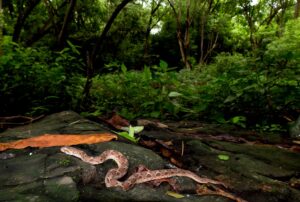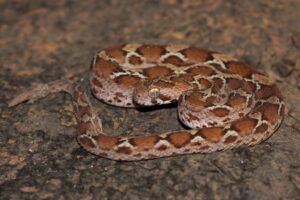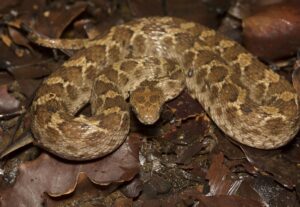Saw-scaled vipers, also known as Indian saw-scaled vipers and little Indian vipers, are poisonous vipers found in parts of Asia, mainly in the Indian subcontinent. They are the smallest of the “Big Four” dangerous snakes in India, along with Russell’s viper, the Indian cobra, and the common krait, and are the nominate species of their genus Echis.
Their scientific name, Echis carinatus, translates to “keeled viper,” where Echis is a Greek word for “viper” and carinatus is a Latin word for “keel.” They are called keeled vipers because of the strongly-keeled scales all over their body.
Primarily nocturnal and crepuscular, they are seldom active during daylight hours. They are most active on humid nights or after rainfall. These snakes are capable of various forms of locomotion, but they mainly move by sidewinding. They are primarily terrestrial snakes but can climb bushes and cacti and are sometimes found up to nine feet off the ground. These vipers migrate to a group den in winter but typically do not travel far.
Scientific Classifications
- Suborder:Serpentes
- Family:Viperidae
- Genus:Echis
- Species:Echis carinatus
Conservation Status
Subspecies
It has five subspecies:
- Astola Saw-scaled Viper (E. c. astolae)
- Multiscale Saw-scaled Viper (E. c. multisquamatus)
- Sochurek’s Saw-scaled Viper (E. c. sochureki)
- South Indian Saw-scaled Viper (E. c. carinatus)
- Sri Lankan Saw-scaled Viper (E. c. sinhaleyus)
Description
Size
They have an average length of 12-35 inches (30-90 cm).
Color and Appearance
These are greyish, reddish, pale buff, olive, or pale brown ground-colored vipers. A whitish trident pattern sits on the top of their head, and a light strip connects the eye with the angle of the jaw. They have a whitish to pinkish belly, either uniform or adorned with light or distinct brown dots.
They have short and rounded heads that are distinct from the neck. The head and nostril are covered with keeled scales. An enlarged supraocular might be present. Across the top of the head are 9-14 interocular scales and 14-21 circumorbital scales. They have 10-12 supralabials separated from the eye by 1-3 rows of scales. The fourth supralabial is the largest, and 10-13 sublabials are also present.
There are 25-39 rows of dorsal scales in their midbody and 143-189 ventral scales on their belly. They also have 21-52 subcaudals and a single anal scale.
Are They Dangerous to Humans
They are venomous snakes containing four types of toxins – cardiotoxins, neurotoxins, hemotoxins, and cytotoxins. Their venom toxicity varies based on location, specimen, milking, sex, and injection method. The intravenous LD50 value in mice is 0.24 mg/kg. The venom of the females is more toxic than that of males. On average, they produce 18 mg of dry venom with a recorded maximum of 72 mg.
Local symptoms of their bites are swelling and pain, which can extend to the entire limb between 12-24 hours. Blisters may appear on the skin in extreme cases. Other dangerous systematic symptoms include coagulation defects and hemorrhages.
Due to their inconspicuousness and very aggressive nature, these vipers are known to cause most snakebite deaths worldwide, killing 4000 to 5000 people in India annually.
Envenomation by this viper should be treated with antivenin therapy and intravenous hydration. At least eight different monovalent and polyvalent antivenins are available against their bites.
The venom of saw-scaled vipers is used in the manufacture of several drugs. Some of them are echistatin, ecarin, and Aggrastat.
Saw Scaled Vipers at a Glance
Distribution
Saw-scaled vipers are primarily found in the Indian subcontinent and parts of the Middle East and Central Asia. On the Indian subcontinent, they occur in India, Bangladesh, Sri Lanka, and Pakistan (including Urak near Quetta and Astola Island off the coast of Makran). In the Middle East, these snakes are found in eastern UAE, Iraq, Oman, Masirah Island, and southwestern Iran. In Central Asia, these snakes live in Afghanistan, Turkmenistan, Tajikistan, and Uzbekistan.

Habitat
They live in dry, moist, deciduous forests, rainforests, grasslands, scrublands, deserts, and semi-deserts. They also inhabit agricultural fields, rocky terrain, scrubs, and open plains.
Their preferred hiding places are under loose rocks, in mounds, piles, leaf litter, and caves. Some specimens are also found in Baluchistan at altitudes of up to 1982 m. Those in the northern parts of their range are known to hibernate in winter.
Lifespan
On average, these vipers live for 12 years in the wild.
Predators
Birds of prey and mongooses are their natural predators.
It produces a loud and raspy warning sound to ward off threats by rubbing parts of their body together. If threatened, they double coil their body into a figure of eight with their head poised in the center. They can lash out rapidly like a released spring.
Diet
Saw-scaled vipers are generalist carnivores who feed on rodents, frogs, lizards, and arthropods such as centipedes, scorpions, and large insects. Their diet varies based on the availability of prey.
Reproduction
They are ovoviviparous by nature. Their mating season is mainly in winter, and they give birth to live young ones from April through August. The average litter size is 3-15, with a recorded maximum of 23. The newborns are 115-152 mm in length.
Similar Species
African Saw Scaled Viper
These are highly venomous vipers found in West Africa.
Egyptian Saw Scaled Viper
These vipers are located in Northeast Africa and Arabian Peninsula.
Painted Saw Scaled Viper
They live in the Middle East and Egypt.
Source
globalnaturefoundation.org, cff2.earth.com, rahulalvares.com, t3.ftcdn.net, wikimedia.org, indiabiodiversity.org, inaturalist.ca











